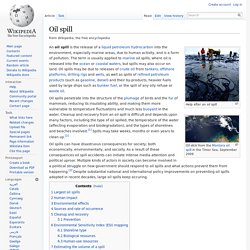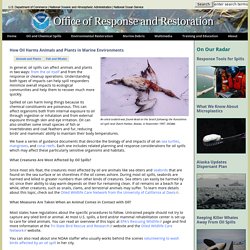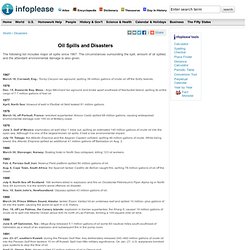

10 Biggest Oil Spills in History. Location: KuwaitGallons: 240 to 336 million How It Happened: As Iraqi forces retreated from Kuwait during the first Gulf War, they opened the valves of oil wells and pipelines in a bid to slow the onslaught of American troops.

The result was the largest oil spill history has seen. Some 240 million gallons of crude oil flowed into the Persian Gulf. The resulting oil slick spanned an area just larger than the size of the island of Hawaii. The Cleanup: Coalition forces managed to seal off some of the open pipelines using smart bombs, but most recovery efforts had to wait until after the war. The largest oil spill the world has seen exacted little permanent damage on coral ecosystems and local fisheries, according to a report by the Intergovernmental Oceanographic Commission at Unesco. Oil spill. Extreme Machines Earth Movers Pictures - Giant Shovel Digging Machine Pictures.
Many of the extreme machines on our list have spent time in mines, but only the Bucyrus RH400 has made a cameo in a Michael Bay film.

The world's largest hydraulic shovel inspired the vehicle form of the Decepticon Demolishor in the 2009 movie Transformers 2: Revenge of the Fallen. When it's not appearing on the silver screen, the RH400 can be found in the Canadian oil sands in Alberta, where this three-story-high behemoth set a production record, excavating 9000 tons of earth in 1 hour. The RH400's shovel can hold up to 94 tons or 57 cubic yards in its shovel, which has what Bucyrus calls a clamshell design that opens at the bottom to empty its payload more quickly.
Two 16-cylinder engines combined generate 4400 hp, running the RH400 and its 14 hydraulic pumps, which hold up to 3400 gallons of fluid—enough to fill a small backyard pool. With an $11 million price tag, it is best to leave as little downtime as possible when working the RH400 in a mine or oil sands. Oil spill. Oil spills penetrate into the structure of the plumage of birds and the fur of mammals, reducing its insulating ability, and making them more vulnerable to temperature fluctuations and much less buoyant in the water.

Cleanup and recovery from an oil spill is difficult and depends upon many factors, including the type of oil spilled, the temperature of the water (affecting evaporation and biodegradation), and the types of shorelines and beaches involved.[1] Spills may take weeks, months or even years to clean up.[2] Oil spills can have disastruous consequences for society; both economically, environmentally, and socially. As a result of these consequences oil spill accidents can initiate intense media attention and political uproar.
Largest oil spills[edit] Oil spills at sea are generally much more damaging than those on land, since they can spread for hundreds of nautical miles in a thin oil slick which can cover beaches with a thin coating of oil. Human impact[edit] Prevention[edit] How Oil Harms Animals and Plants in Marine Environments. The type of oil spilled matters because different types of oil behave differently in the environment, and animals and birds are affected differently by different types of oil.

However, it's not so easy to say which kind is worst. First, we should distinguish between "light" and "heavy" oils. Fuel oils, such as gasoline and diesel fuel, are very "light" oils. Light oils are very volatile (they evaporate relatively quickly), so they usually don't remain for long in the aquatic or marine environment (typically no longer than a few days).
If they spread out on the water, as they do when they are accidentally spilled, they will evaporate relatively quickly. However, while they are present, light oils present two significant hazards. In contrast, very "heavy" oils (like bunker oils, which are used to fuel ships) look black and may be sticky for a time until they weather sufficiently, but even then they can persist in the environment for months or even years if not removed.
Oil Spill Technology. Oil Spill Containment and Recovery. How Do Spills Happen? Oil Spills and Disasters. The following list includes major oil spills since 1967.

The circumstances surrounding the spill, amount of oil spilled, and the attendant environmental damage is also given. March 18, Cornwall, Eng.: Torrey Canyon ran aground, spilling 38 million gallons of crude oil off the Scilly Islands. Dec. 15, Buzzards Bay, Mass.: Argo Merchant ran aground and broke apart southeast of Nantucket Island, spilling its entire cargo of 7.7 million gallons of fuel oil. April, North Sea: blowout of well in Ekofisk oil field leaked 81 million gallons. March 16, off Portsall, France: wrecked supertanker Amoco Cadiz spilled 68 million gallons, causing widespread environmental damage over 100 mi of Brittany coast.